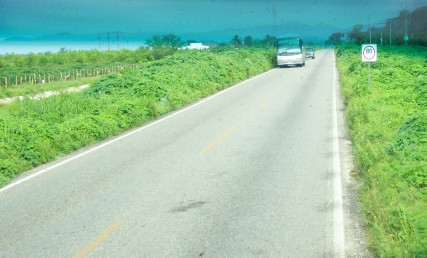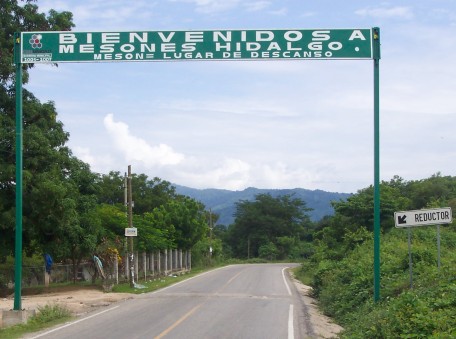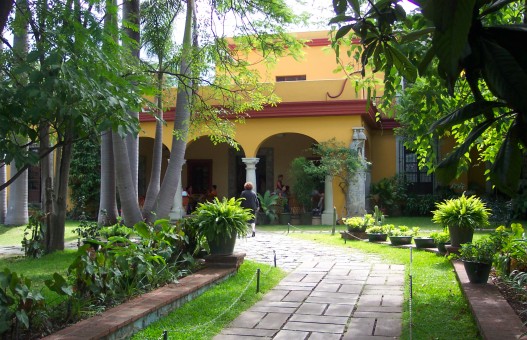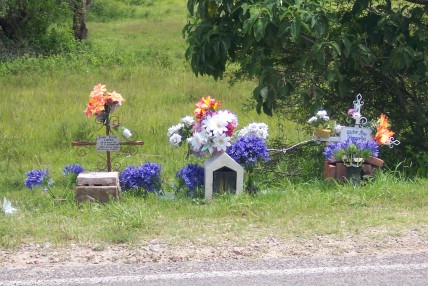 The roads I was on were narrow and mostly had no shoulder, but traffic was light so it was
not a problem. The pavement was good except in a few short sections, mostly within towns.
The roads I was on were narrow and mostly had no shoulder, but traffic was light so it was
not a problem. The pavement was good except in a few short sections, mostly within towns.
The route is a good one if you don't mind lots of climbing, but not for this time of year. The southern coast of Mexico is not a good place to be riding a bicycle in August. Also summer is the rainy season in these parts. The dry months are December through May. December or January might be a good time because the weather is cooler but the vegetation is still green. Daytime temperatures in Oaxaca city in mid-winter are mild, typically with highs in the low 70's F.
 The roads I was on were narrow and mostly had no shoulder, but traffic was light so it was
not a problem. The pavement was good except in a few short sections, mostly within towns.
The roads I was on were narrow and mostly had no shoulder, but traffic was light so it was
not a problem. The pavement was good except in a few short sections, mostly within towns.
Drivers seem to respect cyclists in Mexico. They do like their horns
however. Many will give a short beep just as they pass. I never quite figured out why
they do that. I suppose it's just their way of saying Hola.
Toilet paper. Just as I found in Chile, Mexicans seem to prefer to put their used toilet paper in the trash can rather than in the toilet. The explanation is the same, that the plumbing can't handle it. To test that hypothesis, when I got home I performed an experiment. (OK, OK, I'm an engineer. I have to analyze everything.) I took a wad of toilet paper (I tried this with both Mexican and American TP) and dropped it into a glass of water. Within seconds the TP started to turn to mush. Within 30-60 seconds it had disintegrated to the point where I couldn't even fish it out with my finger. It seems pretty obvious that any plumbing that can handle solid human waste shouldn't have trouble with toilet paper.
 Topes are Mexican speed bumps. There are several at the entrance
and exit to every little town, plus additional ones in the town itself, plus more scattered
seemingly randomly around the countryside. They may be marked with a sign TOPE, or
REDUCTOR DE VELOCIDAD (speed reducer), or just REDUCTOR, or with yellow
cross-hatched stripes, or often with no warning at all - you just have to keep your eyes
peeled. Most are not a problem for a bicycle going 10 or 12 mph, but the cars, trucks, and
busses come almost to a complete halt for each one, which can be a little disconcerting.
Topes are Mexican speed bumps. There are several at the entrance
and exit to every little town, plus additional ones in the town itself, plus more scattered
seemingly randomly around the countryside. They may be marked with a sign TOPE, or
REDUCTOR DE VELOCIDAD (speed reducer), or just REDUCTOR, or with yellow
cross-hatched stripes, or often with no warning at all - you just have to keep your eyes
peeled. Most are not a problem for a bicycle going 10 or 12 mph, but the cars, trucks, and
busses come almost to a complete halt for each one, which can be a little disconcerting.
Hotels in Mexico, unlike many in Chile, almost always provide towel(s),
soap, and toilet paper. However they generally are not already in the room. They give
them to you when you check in.
Window screens. I had planned to write that I never saw a window screen in all of Mexico, but the (almost new) hotel in Teposcolula had them so I can't say that. But for sure they are extremely rare. At my homestay in Oaxaca one day Monica was going around swatting flies. She explained that they come from the chicken place a couple doors down the street, through the rectangular ventilation opening in the wall in the upstairs bathroom. Using sign language and words I described a window screen. She knew exactly what I meant but couldn't think of the Spanish word. I think that may be because there isn't one. In the six different Spanish/English dictionaries I have at home, the closest they could come to a translation of "window screen" was mosquitero, which actually means "mosquito netting", tela metálica, which means "wire mesh", or rejilla, which means "ventilation grille". I think you'd have to say something like, tela metálica contra los insectos (wire mesh for insects).
 Spanish instruction at the Instituto Cultural de Oaxaca was excellent.
They also have a beautiful campus. There are a number of other Spanish-teaching
organizations in Oaxaca as well.
Spanish instruction at the Instituto Cultural de Oaxaca was excellent.
They also have a beautiful campus. There are a number of other Spanish-teaching
organizations in Oaxaca as well.
Homestay is the term for living with a local family while attending school.
We were given the option of homestay or staying in a posada (inn). About half the group
opted for each choice. If you really want to learn Spanish, absorb true Mexican culture, and
make new friends, the homestay is the obvious way to go. The Instituto Cultural has long-term
relationships with a number of families, so the people you are staying with are known to
be reliable. You can take some or all your meals at the homestay, or if you can't handle
the idea of eating tortillas three times a day, you can opt to be responsible for your own
meals.
Dogs are a major nuisance for cycling in Mexico. They are everywhere and never seem to be confined. Some just ignore you but many will chase, barking and snarling, which greatly detracts from the cycling experience. Yelling at them has absolutely no effect, nor does squirting them with a water bottle. I haven't tried Mace, but I'm seriously tempted.
 Roadside shrines are those little monuments by the side of the road to
commemorate people who died in traffic accidents. I was surprised that, except for the
stretch of highway 125 between Putla and Tlaxiaco, I have seen fewer of them than in Chile or
even back home in California. My theory is that, outside of the major cities, few Mexicans
own cars. They travel less than more-prosperous Latinos in Chile and the US and when
they do travel it is by bus or taxi, which are much safer than private automobiles
Roadside shrines are those little monuments by the side of the road to
commemorate people who died in traffic accidents. I was surprised that, except for the
stretch of highway 125 between Putla and Tlaxiaco, I have seen fewer of them than in Chile or
even back home in California. My theory is that, outside of the major cities, few Mexicans
own cars. They travel less than more-prosperous Latinos in Chile and the US and when
they do travel it is by bus or taxi, which are much safer than private automobiles
The family, as most people know, is very important in Mexico. Mexicans adore their kids. In four weeks I never heard parents screaming at their children as you often do in the US. I also heard very few screaming kids. When adult children move out from their parents' home, they try to make their new home close by (within a few blocks if possible) so that they can visit frequently. That's one reason why I feel that even if the US opened up its borders there would not be a huge rush of Mexicans moving north.